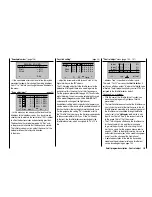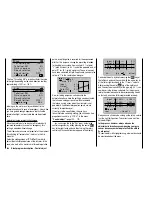
287
Detail program description - Control adjust
"Channel 1 curve"
(page 119)
Input
Output
Point
?
0%
0%
0%
C1
nor mal
Cur ve
Cur ve off
This function is a type of "convenient exponential curve"
for the throttle/pitch joystick and the mixer functions
connected to it.
If ever
, this curve should only be applied "cautiously" at
the very end, when all adjustments have been made. It
should never be used for the throttle/pitch adjustment!
The overlappings result in "nasty" effects.
With this, all helicopter-specifi c settings which can
be made on the "workbench" are now completed.
The further fi ne-tuning must take place in fl ight. The
fl ight-tested, (hopefully) minor (digital) trim settings are
automatically saved.
Larger deviations should fi rst be mechanically adjusted
or adjusted according to the previously discussed
settings.
Further settings
Following this programming example, you have provided
a helicopter with a basic adjustment for the hovering
training and simple trips. Depending on your knowledge
and experience as a pilot, additional functions can, of
course, also be activated.
If you want to fl y at different speeds and with different
trimming, you activate the so-called "fl ight phases",
which can be called with assigned switches as an
alternative to the previously described "normal phase".
For this purpose, fi rst open the menu …
"Phase setting"
(page 132)
… whereby the symbols appearing in the second
column after the switch assignment in the "
Phase
assignment
" menu have the following meanings:
"–":
No phase switch available
"+":
Phase switch available
"
": Currently active phase
Pha1
Pha2
Pha3
Name
ph.Tim.
Pha4
Autorot
–
–
–
+
Auto
However, you should consider beforehand whether you
want to activate the up to six additional fl ight phases
with single switches or, more logically, with three-stage
switches in addition to the autorotation phase. The latter
possibility is more logical and usually more clearly laid
out.
In the upper fi gure the line "
Autorot
" is already selected.
When activated, the autorotation phase always has
precedence over any other phases you assign switches to.
However, in the "Name" column you fi rst assign
"meaningful" names to Phases 1 to 3, which are
adopted from a list. These identifi cations serve for the
better differentiation and are shown later in the base
screen and for all fl ight-phase dependent menus, for
example:
Pha1
Pha2
Pha3
Name
ph.Tim.
Pha4
+
+
Nor mal
Hover
–
–
0.1s
0.1s
0.1s
0.1s
0.1s
Speed
Autorot
Auto
Then, in the fourth column, enter the switching time
with which the FROM phase should switch TO the next
respective phase. Approximately 1 s should suffi ce:
Pha1
Pha2
Pha3
Name
Sw.time
Pha4
+
+
Nor mal
Hover
–
–
1.1s
1.1s
5.0s
0.1s
Speed
Autorot
Auto
1.1s
This value can also be adjusted later according to your
personal preferences. Please observe in the process
that TO the autorotation phase, whose name is defi ned
as "
Autorot
", is switched without a time delay. If
necessary, enter the time with which a change FROM
the autorotation phase to a different phase should be
affected.
In order to be able to switch between the individual fl ight
phases, the assignment of the individual switches or the
three-stage switch is necessary.
Summary of Contents for mx-20 Hott
Page 41: ...41 Your notes...
Page 49: ...49 Your notes...
Page 55: ...55 Your notes...
Page 81: ...81 Your notes...
Page 85: ...85 Your notes...
Page 89: ...89 Your notes...
Page 99: ...99 Detail program description Control adjust...
Page 127: ...127 Detail program description Control adjust...
Page 131: ...131 Detail program description Control adjust...
Page 163: ...163 Detail program description Control adjust...
Page 191: ...191 Detail program description Control adjust...
Page 207: ...207 Detail program description Control adjust...
Page 228: ...228 Detail program description Control adjust...
Page 229: ...229 Detail program description Control adjust...
Page 251: ...251 Detail program description Control adjust...










































